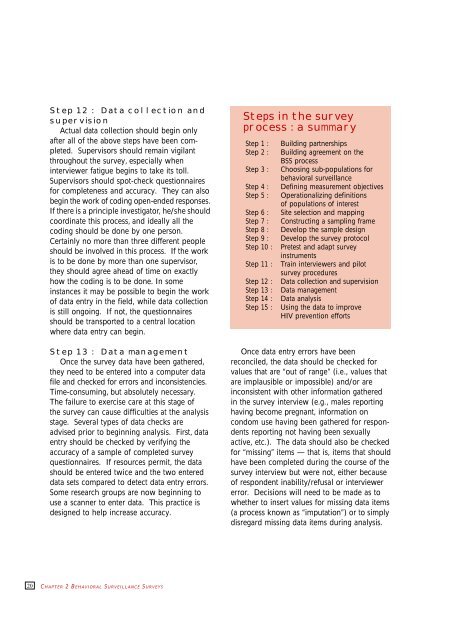Behavioural Surveillance Surveys - The Wisdom of Whores
Behavioural Surveillance Surveys - The Wisdom of Whores
Behavioural Surveillance Surveys - The Wisdom of Whores
You also want an ePaper? Increase the reach of your titles
YUMPU automatically turns print PDFs into web optimized ePapers that Google loves.
Step 12 : Data collection and<br />
supervision<br />
Actual data collection should begin only<br />
after all <strong>of</strong> the above steps have been completed.<br />
Supervisors should remain vigilant<br />
throughout the survey, especially when<br />
interviewer fatigue begins to take its toll.<br />
Supervisors should spot-check questionnaires<br />
for completeness and accuracy. <strong>The</strong>y can also<br />
begin the work <strong>of</strong> coding open-ended responses.<br />
If there is a principle investigator, he/she should<br />
coordinate this process, and ideally all the<br />
coding should be done by one person.<br />
Certainly no more than three different people<br />
should be involved in this process. If the work<br />
is to be done by more than one supervisor,<br />
they should agree ahead <strong>of</strong> time on exactly<br />
how the coding is to be done. In some<br />
instances it may be possible to begin the work<br />
<strong>of</strong> data entry in the field, while data collection<br />
is still ongoing. If not, the questionnaires<br />
should be transported to a central location<br />
where data entry can begin.<br />
Step 13 : Data management<br />
Once the survey data have been gathered,<br />
they need to be entered into a computer data<br />
file and checked for errors and inconsistencies.<br />
Time-consuming, but absolutely necessary.<br />
<strong>The</strong> failure to exercise care at this stage <strong>of</strong><br />
the survey can cause difficulties at the analysis<br />
stage. Several types <strong>of</strong> data checks are<br />
advised prior to beginning analysis. First, data<br />
entry should be checked by verifying the<br />
accuracy <strong>of</strong> a sample <strong>of</strong> completed survey<br />
questionnaires. If resources permit, the data<br />
should be entered twice and the two entered<br />
data sets compared to detect data entry errors.<br />
Some research groups are now beginning to<br />
use a scanner to enter data. This practice is<br />
designed to help increase accuracy.<br />
Steps in the survey<br />
process : a summary<br />
Step 1 :<br />
Step 2 :<br />
Step 3 :<br />
Step 4 :<br />
Step 5 :<br />
Step 6 :<br />
Step 7 :<br />
Step 8 :<br />
Step 9 :<br />
Step 10 :<br />
Step 11 :<br />
Step 12 :<br />
Step 13 :<br />
Step 14 :<br />
Step 15 :<br />
Building partnerships<br />
Building agreement on the<br />
BSS process<br />
Choosing sub-populations for<br />
behavioral surveillance<br />
Defining measurement objectives<br />
Operationalizing definitions<br />
<strong>of</strong> populations <strong>of</strong> interest<br />
Site selection and mapping<br />
Constructing a sampling frame<br />
Develop the sample design<br />
Develop the survey protocol<br />
Pretest and adapt survey<br />
instruments<br />
Train interviewers and pilot<br />
survey procedures<br />
Data collection and supervision<br />
Data management<br />
Data analysis<br />
Using the data to improve<br />
HIV prevention efforts<br />
Once data entry errors have been<br />
reconciled, the data should be checked for<br />
values that are “out <strong>of</strong> range” (i.e., values that<br />
are implausible or impossible) and/or are<br />
inconsistent with other information gathered<br />
in the survey interview (e.g., males reporting<br />
having become pregnant, information on<br />
condom use having been gathered for respondents<br />
reporting not having been sexually<br />
active, etc.). <strong>The</strong> data should also be checked<br />
for “missing” items — that is, items that should<br />
have been completed during the course <strong>of</strong> the<br />
survey interview but were not, either because<br />
<strong>of</strong> respondent inability/refusal or interviewer<br />
error. Decisions will need to be made as to<br />
whether to insert values for missing data items<br />
(a process known as “imputation”) or to simply<br />
disregard missing data items during analysis.<br />
20<br />
C H A PTER 2 B EHAV I OR A L S U R V EI L L A NC E S U R V EY S










